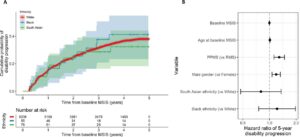
Overview
Guidelines for PET scans in diagnosing AD – Gil Rabinovici
- Amyloid-PET broadly useful for diagnosis
- Tau-PET often useful, but some situations carry higher risk of false negatives
Monitoring patients on anti-amyloid antibodies – Liana Apostolova
- Patients should routinely receive MRI scans to check for ARIA
- Those with edema or microhemorrhages can resume treatment after symptoms clear, but not those with macrohemorrhages
Presentation Summaries
With anti-amyloid antibody trials and therapies hinging on accurate measurements of amyloid, position emission tomography (PET) tracers have never been more essential in Alzheimer’s. Since the first amyloid-PET tracer, florbetapir, received Food and Drug Administration (FDA) approval in 2012, the ability to assess AD pathology ante mortem has revolutionized our understanding and treatment of the disease. Novel Alzheimer’s therapies have also provided new roles for magnetic resonance imaging (MRI) in monitoring for amyloid-related imaging anomalies (ARIA). In this article, we discuss the latest guidelines on how PET scans should be used for diagnosing Alzheimer’s and when patients on anti-amyloid therapeutics should receive MRIs.
When should amyloid and tau PET be used in the clinic?
The world of Alzheimer’s has changed dramatically in the decade since amyloid-PET first entered the clinic. The Appropriate Use Criteria (AUC) written at that time, according to Gil Rabinovici (UCSF), saw amyloid imaging as an adjunct that could guide clinicians who were unsure of a diagnosis. In response to advances in the field, especially the advent of tau-PET, the Alzheimer’s Association and the Society for Nuclear Medicine and Molecular Imaging convened a working group, led by Rabinovici and Keith Johnson, to write an update set of AUC. Informed by a literature review from the Pacific Northwest Evidence-Based Practice Center at OHSU, they identified 17 scenarios clinicians might encounter and rated the appropriateness of amyloid- and tau-PET on a scale of 1 (rarely appropriate, highly confident) to 9 (appropriate, highly confident).
Amyloid-PET is appropriate for:
- diagnosing patients presenting MCI or dementia at any age
- evaluating for anti-amyloid treatment
- assessing prognosis for MCI
- evaluation when cerebrospinal fluid (CSF) biomarkers provide inconclusive results
- It may also be appropriate for monitoring responses to anti-amyloid therapies and in patients presenting Subjective Cognitive Decline (SCD) with elevated risk factors.
Tau-PET is appropriate for:
- MCI or dementia in patients under 65 or with atypical presentation. Since many MCI/AD patients over 65 are at Braak IV, however, the group was less certain about examining them with tau-PET due to the risk of false negatives.
- patients with ambiguous CSF biomarkers and for staging patients with definitive biomarker results.
The recommended scope for tau-PET is narrower, both because its cutoffs are designed to detect advanced tau pathology (Braak V-VI) and there were fewer data to go by in many scenarios.
Finally, neither one should ever be used for non-medical reasons (such as by insurance companies assessing risk) or for examining potential carriers of autosomal-dominant AD mutations in lieu of genotyping.
Monitoring patients on lecanemab for ARIA
The approval of lecanemab by the FDA represents a major turning point in treating Alzheimer’s. Like other anti-amyloid antibodies before it, however, lecanemab greatly increases the risk of ARIA, damaging the organ it aims to treat. Liana Apostolova (Indiana Alzheimer’s Disease Research Center) reported the output of the AD Therapeutic Work Group, which sought to translate knowledge from the drug’s Package Insert and trial data into guidelines for clinicians.
Patients on lecanemab should receive:
- MRI scans checking for ARIA, consisting of a baseline scan 3-4 months prior to treatment and scans following the 5th, 7th, and 14th infusions.
- Urgent scans in response to any of the following ARIA-related symptoms: headache, confusion, visual changes, dizziness, nausea, gait difficulty, seizures, encephalopathy, and focal neurological deficits.
- The MRI sequences should consist of: T1, T2, or Fluid Attenuated Inversion Recovery (FLAIR); T2* gradient echo (GRE) or susceptibility-weighted imaging (SWI); and a quick diffusion weighted imaging (DWI) scan. Ideally, these should be performed at a strength of 3T.
Should ARIA be detected,
- suspend treatment for any symptomatic ARIA or any moderate/severe asymptomatic ARIA
- re-image monthly.
- If patients wish to continue treatment following resolution of ARIA-E or stabilization of microhemorrhages in ARIA-H, it can be resumed, but it should not be resumed following a macrohemorrhage.
Moderate/severe ARIA is defined as:
- ARIA-E (edema): a single region of at least 5cm or multiple below 10cm
- ARIA-H (hematoma): 5 or more new microhemorrhages, 1 new macrohemorrhage, or 2 or more new areas of superficial siderosis.
Apostolova stressed the need for medical centers to prepare for increased ARIA incidence as anti-amyloid antibodies are deployed in the clinic. This preparation includes MRI scanners that can be used for unscheduled emergency scans, MRI readers trained to recognize ARIA, and clinicians with the experience to treat it.





